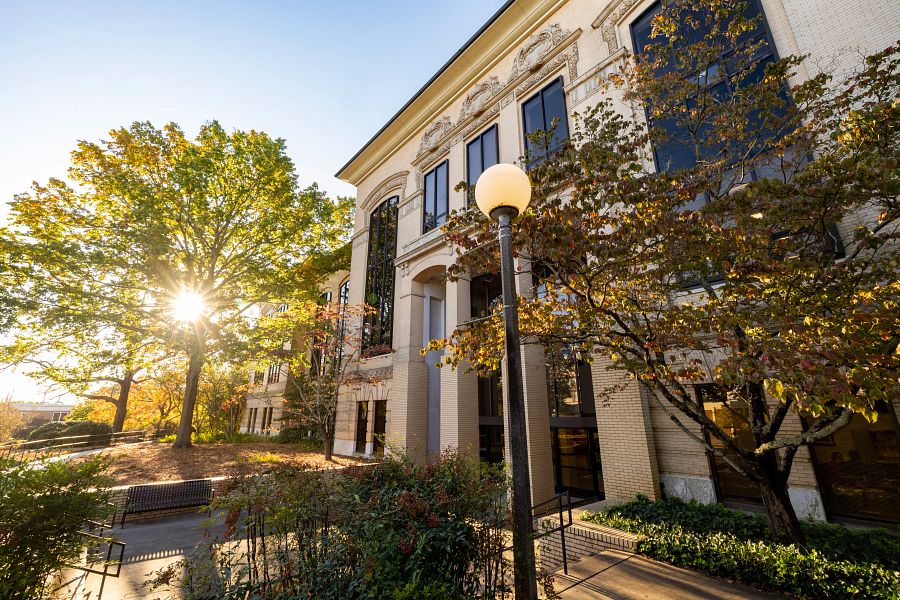All of these fruits require good sites, pollination, pest control and maintenance. The best site is one with plenty of sunlight, air drainage and good soil structure and chemistry.
Plant your trees where they will get the most sunlight. If you plant them in rows, orient them north to south.
Put them, too, where cold air will drain away from them on frost nights. Cold air drains downhill, so put fruit trees on top of a hill on a southeastern-facing slope. If the area is flat, put them where cold air can drain away unblocked by bordering woods.
Well-drained Soil
The soil should be well-drained. A sandy loam to sandy clay loam is best. Have soil samples analyzed for nematodes and pH. Add lime to bring the soil to a pH of 6.5. Your county extension agent can help with this. Now is the best time to analyze the soil for next year's orchard planting.
Select varieties that will do well in your specific climate. Georgia has two systems for designating hardiness zones.
U.S. Department of Agriculture zones in the state range from 6b (the coldest) to 8b. These are most often used by nurseries and seed catalogues. Georgia designations range from 1 (the coldest) to 5. These are used in University of Georgia Extension Service bulletins about tree fruit production.
Protect Pollinators
Pollen is moved by wind and insects. Bees and other pollinators improve the pollination of most fruit trees, so protect them. Don't spray insecticides when they're working the flowers.
Fruit trees are either self-fruitful or self-unfruitful. The latter group requires pollination from a different but compatible variety known as a pollinizer. Peaches and nectarines don't require pollinizers, but apples, pears and plums do.
Many apple varieties can be grown in Georgia. They are listed in the chart below with their planting zones and pollination codes. Stayman must be matched with a male fertile member of group C to produce fruit.
Pears, Fire Blight
Select pears based on their susceptibility to fire blight. A number of Asian and hybrid pears are grown in Georgia. Asian pears have to be planted with another compatible pear variety.
There are hundreds of peach varieties to choose from. Select them based on planting zone and harvest date. The ideal variety requires so many hours of chilling that it breaks dormancy, blooms and sets fruit when the danger of frost is over. Of course, most varieties aren't ideal.
A few nectarine varieties are also available. However, the lack of fuzz makes the fruit more susceptible to insects and diseases.
Several new plum varieties have been developed for the Southeast. They generally have very low chill requirements and thus flower at about the same time. Plant them along with a different variety for pollination.
| Apples for Georgia | |||
| Varieties | Zone | Uses | Pollination Code |
| Anna | 5 | Early, dessert (red blush) | A |
| Dorsett Golden | 5 | Early, dessert (yellow) | A |
| Jerserymac | 1,2,3 | Fresh, sauce and pies | B |
| Redgold | 1,2,3 | Dessert | B |
| Priscilla | 1,2,3 | Sub-acid dessert | C |
| Mollie's Delicious | 3,4 | Fresh, sauce and pies | B |
| Ozark Gold | 1,2,3 | Dessert (yellow) | C |
| Red Delicious | 1,2,3,4 | Sweet, fresh, or salads | B |
| Golden Delicious | 1,2,3,4 | Sub-acid, yellow, all purpose | C |
| Stayman | 1,2,3 | Tart, all-purpose | C-sterile |
| Yates | 1,2,3,4 | Small, subacid, mellow, juicy | B |
| Granny Smith | 1,2,3,4 | All-purpose (yellow green) | C |
| * To determine compatible pollinizing pairs, match the letter codes. | |||






